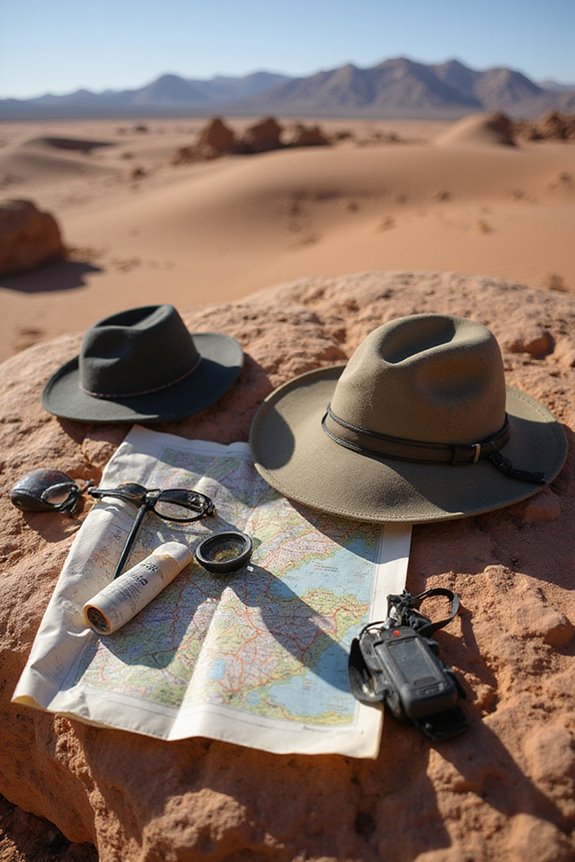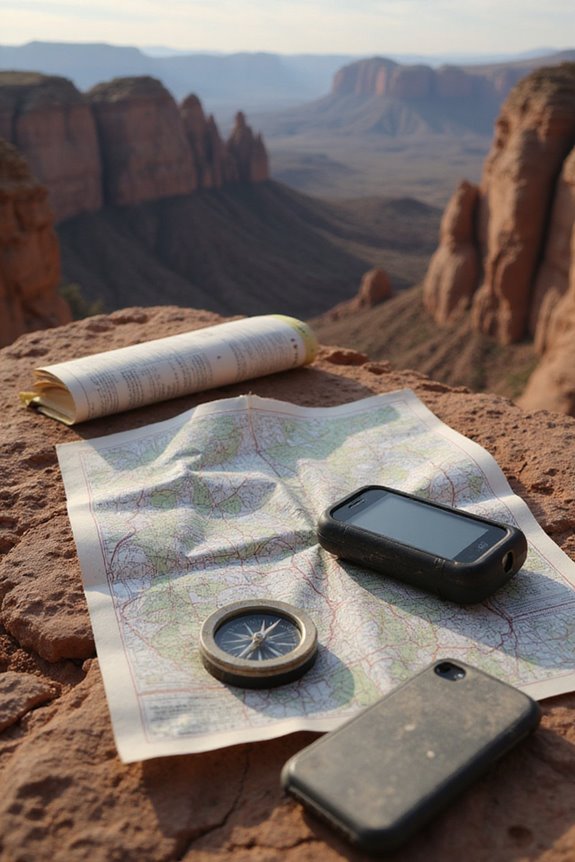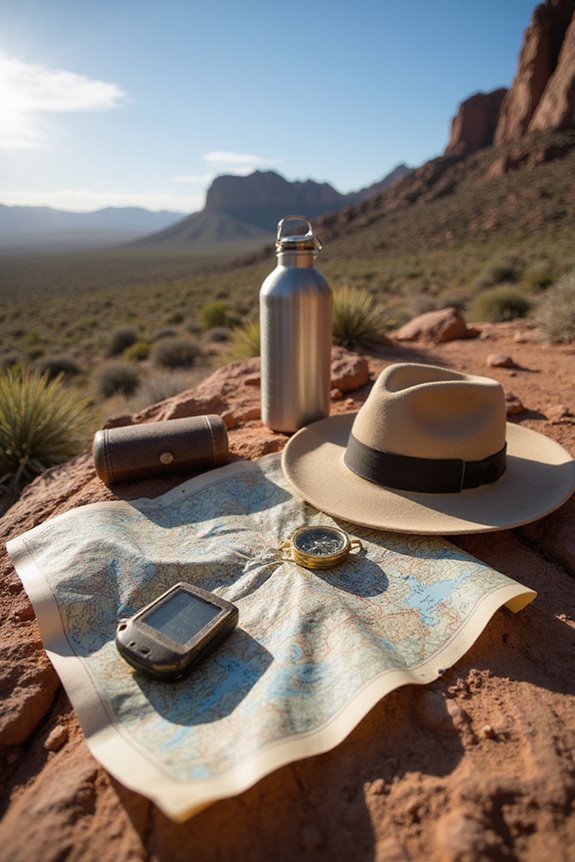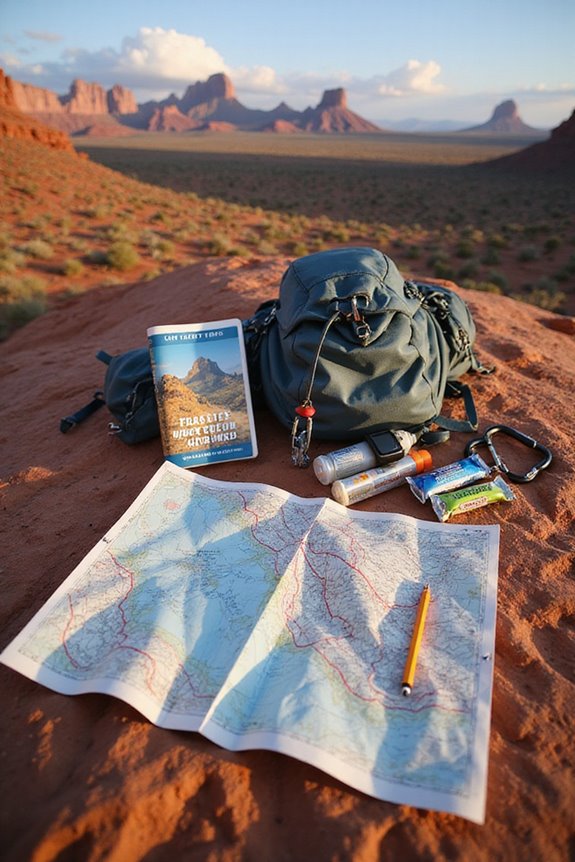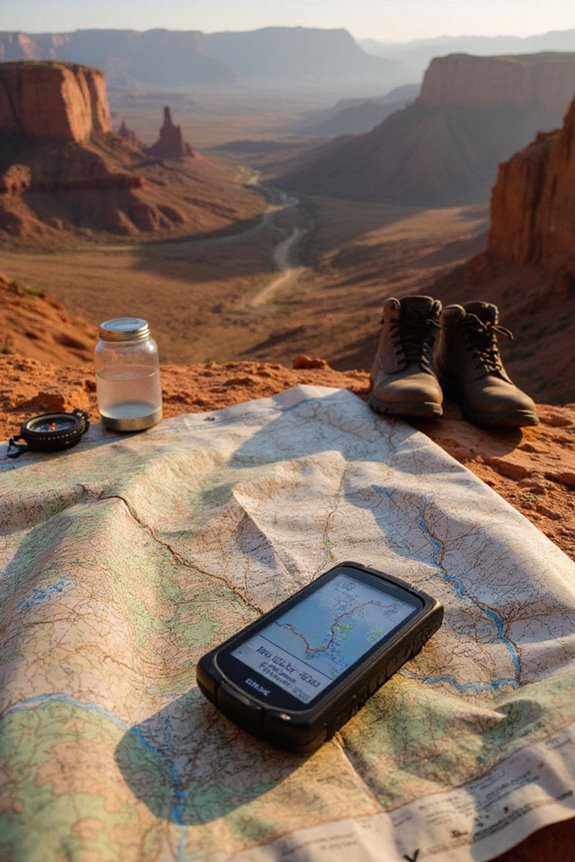When we pack for desert navigation, we’ve gotta prioritize hydration, shelter, clothing, navigation tools, and food supplies—because nobody likes sipping on sand! Let’s carry at least a gallon of water per day, and don’t forget your hydration pack for easy sipping. A sturdy tent with a rainfly is essential since sandy storms can come outta nowhere. Lightweight, breathable clothing and high-SPF sunscreen will keep us cool. And trust me, those snack bars will save us from hunger! Stick around, and we’ll cover more essentials in no time.
Key Takeaways
- Carry at least 1 gallon of water per person per day to prevent dehydration under the desert sun.
- Utilize a magnetic compass and a Garmin eTrex SE for accurate navigation in vast desert landscapes.
- Wear lightweight, breathable clothing with long sleeves and sun protection accessories like hats and sunglasses to shield against the sun.
- Pack high-quality binoculars with integrated compasses for distant visibility and navigation aid in the desert terrain.
- Consider lightweight cooking gear and non-perishable food options to maintain energy levels during your expedition.
Hydration Essentials
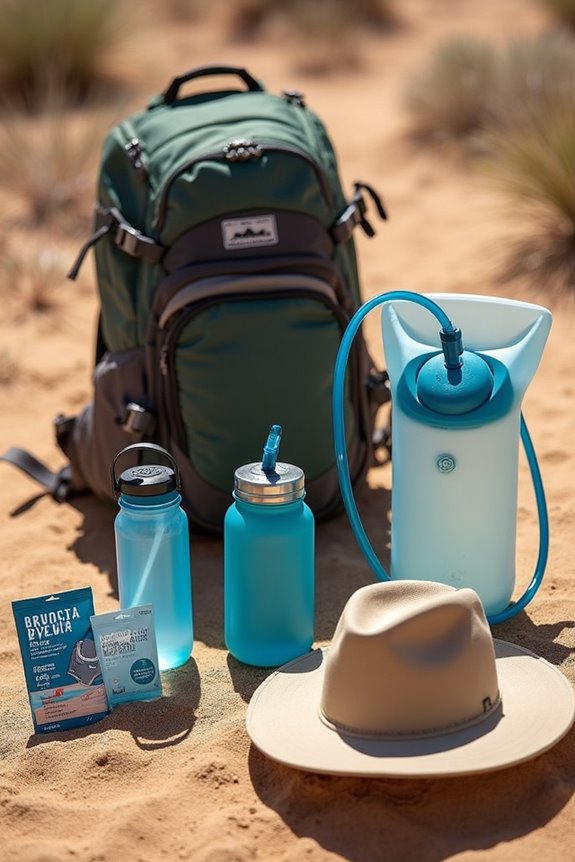
When we think about desert navigation, one of the first things that should pop into our minds is hydration—after all, it’s the lifeblood on those sun-baked trails! We need to carry at least 1 gallon of water per person per day, and trust us, you’ll thank yourself later. Hands-free hydration packs are a game changer, letting us sip away while we conquer those rugged paths. But let’s not forget electrolyte management! A good stash of electrolyte tablets or infused snacks keeps our energy up and cramps at bay. And pro tip: drink regularly to avoid chasing thirst—it’s like trying to catch a cactus in the desert! For extended desert adventures, consider bringing along collapsible water bottles that save space in your pack when empty while still providing substantial capacity when needed. So stock up, stay cool, and let’s embrace the freedom that hydration brings!
Shelter and Sleeping Gear
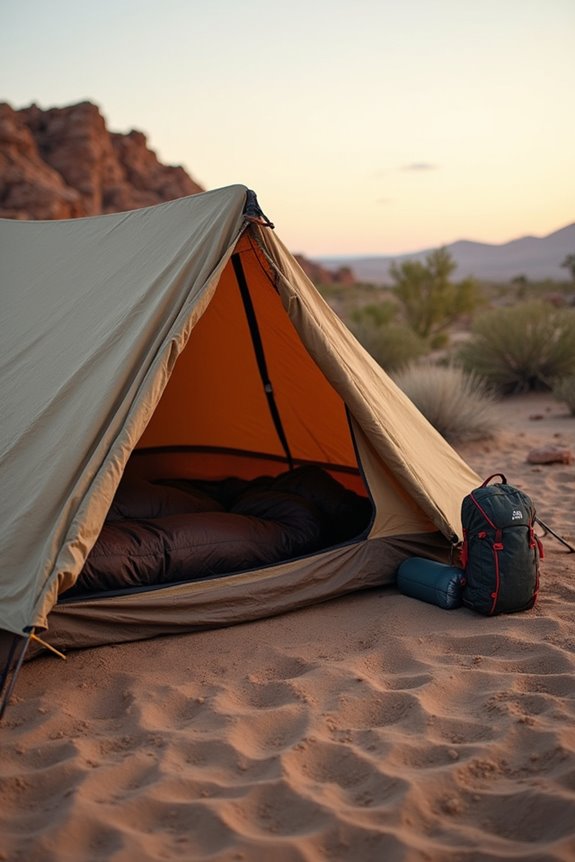
Ready to tackle the desert? Let’s chat about shelter and sleeping gear! We’ve gotta pick a sturdy tent that can brave those high winds and chilly nights. A lightweight, four-season or well-ventilated three-season tent works wonders for easy transport. Don’t forget a rainfly – who wants unexpected showers ruining our adventure?
For our sleeping arrangements, we need a sleeping bag rated for at least 20°F. Pair it with a good sleeping pad or air mattress to keep us comfy and insulated from the cold, hard ground. Choose a tent with high waterproof rating of at least 3000mm to ensure protection from unexpected desert storms. And while we’re out there, regular tent maintenance is essential to keep our home sand-free. With a solid setup, we can focus on our journey and let the desert’s magic envelop us!
Clothing and Personal Items
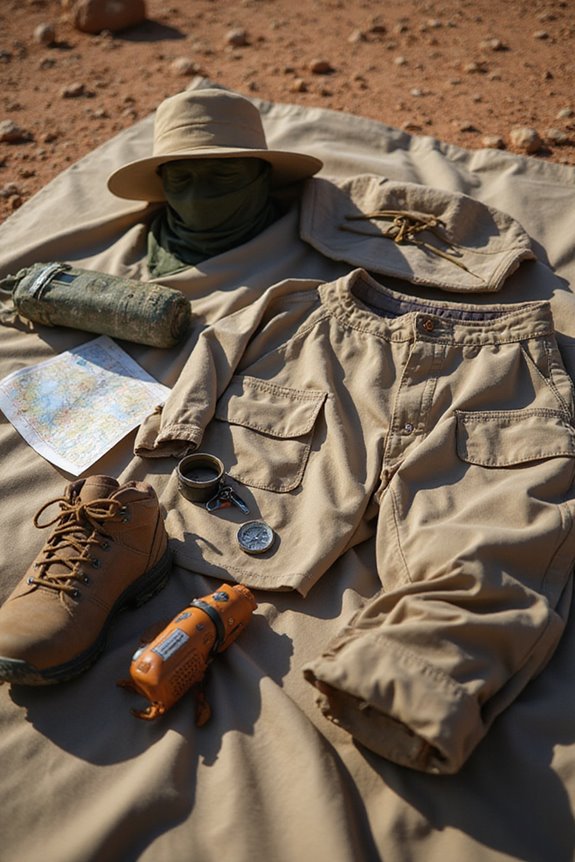
As we gear up for our desert adventure, let’s not underestimate the importance of choosing the right clothing and personal items! Lightweight and breathable clothing materials are our friends out there. Think long-sleeve shirts with moisture-wicking fabrics and tight-knit UV protection—nobody wants a sunburned back! Loose-fitting pants or clever zip-off shorts are essential for keeping cool while shielding us from sun and sand.
Let’s not forget our sun protection accessories: wide-brimmed hats, polarized sunglasses, and those trusty bandanas can be lifesavers. A good sunscreen with high SPF is non-negotiable! We’ll also want quick-dry towels and personal hygiene items for that fresh feeling after a long trek. Trust me, we’ll need it on those scorching trails! Don’t forget to pack a BPA-free water bottle that can withstand extreme temperatures for safe hydration during your desert navigation.
Navigation Tools and Safety Gear
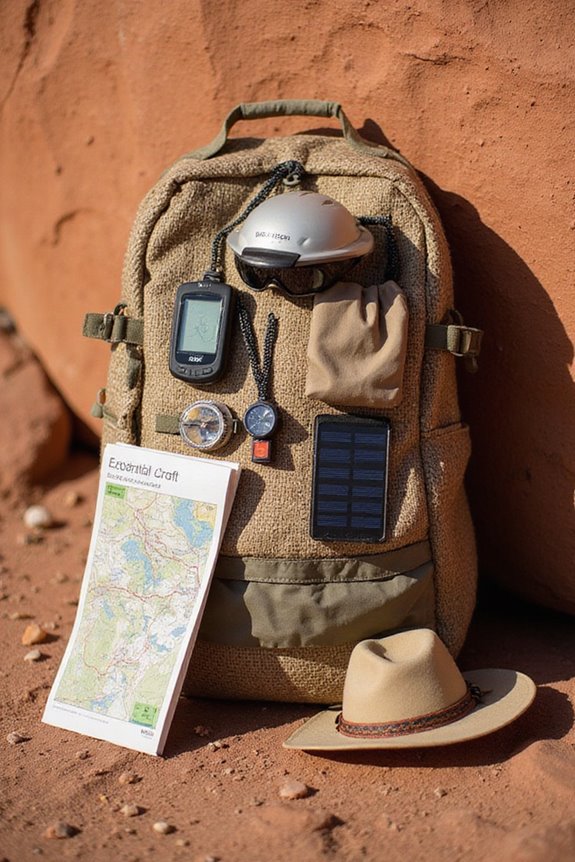
While we can’t afford to underestimate the challenges of traversing the vast, sun-baked expanses of the desert, having the right navigation tools and safety gear is our best bet for a successful adventure. We swear by a trusty magnetic compass—simple, sturdy, and reliable when the GPS falters. Digital compasses can spice things up with real-time data, perfect when landmarks disappear into the heat haze. For extended desert expeditions, consider a Garmin eTrex SE with its impressive 168-hour battery life in standard mode. Don’t forget high-quality binoculars with integrated compasses; they make identifying distant hazards a breeze. Safety gear is critical too. Whistles and signal mirrors are lifesavers when we’re lost. A personal locator beacon? Absolute necessity. So, let’s gear up and embrace the freedom of the desert, armed with the best navigation technology out there!
Cooking and Food Supplies
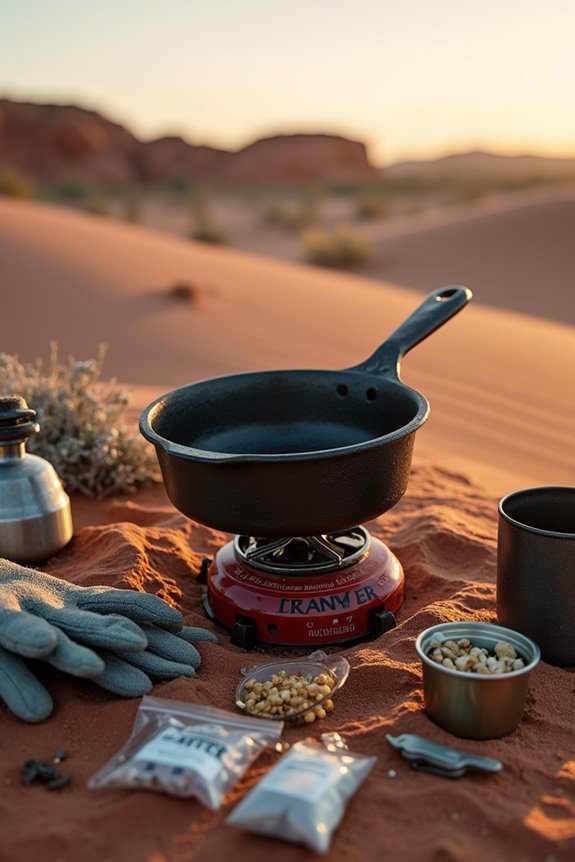
When we hit the trails in the desert, packing the right cooking and food supplies can mean the difference between a rewarding adventure and a need for an emergency snack break. We’ll want non-perishable options like energy bars, nuts, and jerky—they’re compact and high-calorie, perfect for our journey. Meal planning is essential; let’s minimize moisture and choose durable packing to guarantee our food stays fresh. Resealable bags are our best friends here! As for cooking, lightweight stoves and compact utensils will keep things simple, letting us focus on the beautiful views rather than complicated meals. A portable backpacking stove with piezoelectric ignition systems ensures reliable cooking even in unpredictable desert conditions. And hey, don’t forget water purification tablets! Staying hydrated fuels our freedom, allowing us to roam the desert with no worries. Let’s hit the trails!
Frequently Asked Questions
What Personal Identification Should I Carry in the Desert?
When we venture into the desert, we should always carry essential ID documents, like a government-issued photo ID. Don’t forget to include emergency contacts; they’ll help us stay connected and safe amid the wild freedom.
How Can I Protect My Skin From Extreme Sun Exposure?
When the sun’s blazing, we’ve gotta plan ahead. With proper sunscreen application and protective clothing, we can dance freely under that bright sky, staying cool and shielded from harmful rays while enjoying every moment.
What Are Effective Ways to Signal for Help in the Desert?
When we think about signaling for help in the desert, using signal mirrors and emergency flares can be lifesavers. We’ve gotta stay visible and make our presence known to others in the vastness ahead.
How Do I Prevent Animal Encounters While Camping?
Did you know that 75% of wildlife encounters occur due to human negligence? By practicing wildlife awareness and campsite safety, we can relish our freedom while minimizing risks, ensuring both our adventure and nature’s integrity thrive.
What Should I Do if I Get Lost in the Desert?
If we find ourselves lost in the desert, we’ll stay calm and apply essential survival techniques. Let’s use the sun for navigation, create shade, and signal for help, maximizing our chances of being rescued.

